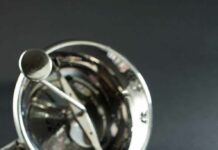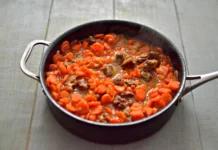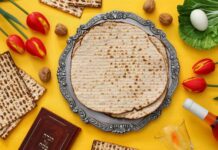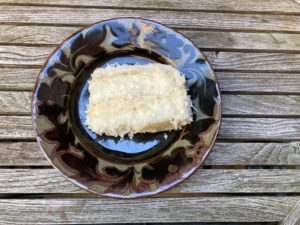
As spring blossoms, we naturally gravitate toward lighter, fresher flavors.
I begin to move from the heavier, deeper pumpkin, chocolate and caramel recipes to citrus and coconut desserts. No, these are not “light” in the sense of diet, fat or calories, but they feel more seasonal as the weather warms.
The coconut cake was a gift to a friend for his birthday — we planned to surprise him with a small group of vaccinated friends at my house for dinner, and his partner informed me that a white coconut cake was his favorite. I looked at a number of different recipes and eventually came up with this one, which uses coconut ingredients in both the cake and the icing, and also uses coconut extract. If you can’t find the extract, you can use a vanilla or almond in its place.
This can easily be made pareve with the use of coconut oil, margarine or other nondairy option in the place of the butter/cream cheese. The cake uses only the egg whites, but don’t toss the yolks; make lemon or lime curd, custard, crème brulee, flan or a rich omelet, frittata or scramble.
Cake:
5 egg whites
¾ cup unsweetened coconut milk
1 stick butter, softened
¼ cup coconut oil
1 ¾ cup sugar
1 teaspoon coconut extract (or 1 teaspoon vanilla and/or ½ teaspoon almond extract)
2½ cups cake flour
1 tablespoon baking powder
½ teaspoon salt
1 cup shredded sweetened coconut
Icing:
1 stick butter, softened
1 8-ounce package cream cheese, softened
¼ cup coconut oil
5 cups powdered sugar
¼ cup unsweetened coconut cream
½ teaspoon coconut extract
Topping:
2 cups shredded sweetened coconut
Heat your oven to 350 degrees F. Spray two pans with cooking oil and line them with parchment; spray the parchment. Set the pans aside.
Whisk the egg whites and coconut milk until combined; set aside. Mix the dry ingredients in a medium bowl; set aside.
In a mixing bowl, beat the butter, coconut oil, sugar and extracts for about a minute. Slowly add the dry ingredients until they are just mixed. Add in the egg white mixture and beat it for about 2 minutes. Add the shredded coconut and mix until just combined.
Pour the batter into the pans, dividing evenly, and bake for 25 minutes, or until done, when the edges and surface are starting to turn a bit golden and/or a toothpick comes out clean and/or the cake springs back when lightly pressed. Cool the cakes completely and remove them from the pans.
For the icing, blend the butter, cream cheese and coconut oil until fluffy. Slowly add powdered sugar and coconut cream until smooth. Add the extract and mix well. If the icing is too “dry,” you can add some more coconut cream or coconut milk a tablespoon at a time until the desired consistency is achieved.
When the cake is completely cool, ice the bottom layer of the cake, sprinkle it with ½ cup flaked coconut, then place the top layer on and ice the entire cake. Using your hands, gently place and lightly press the rest of the coconut on the top and sides of the cake.
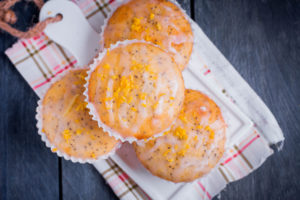
Lemon Chia Seed Muffins
Makes 12 muffins
A friend sent me a recipe for lemon poppy seed muffins with lemon-rose glaze that she highly recommended.
Ever grateful for the recs of baking friends, I checked out the recipe — and planned to make it — though I was going to skip the rose water in the glaze. That’s one of those love it or hate it ingredients; I always feel like I should be schmearing it on my skin or pouring it in a bath.
I had the batter part of the way done when I realized that the bag of what I thought was poppy seeds in my pantry was actually chia seeds. So that was a bit of a glitch … or was it?
I did some research and found that many reputable cooks use poppy and chia seeds interchangeably. An added benefit: Chia seeds are one of those alleged superfoods loaded with fiber, calcium, magnesium and phosphorous. So, going forward, I will probably use chia seeds when recipes call for poppy and tell myself that my muffins and cakes are healthy!
The version below is dairy, but can easily be made pareve by swapping nondairy milk for the buttermilk. These cook at a slightly lower temperature than many other baked goods. I am not sure of the science behind that move, but you can’t argue with the results. And if you wish to bring the rose water flavor in as the original version suggested, simply add a half teaspoon to the glaze.
For the muffins:
¾ cup sugar
1 teaspoon lemon zest
2 tablespoons fresh lemon juice
2 eggs
½ cup oil (canola or vegetable)
½ cup buttermilk
1¼ cup flour
¼ teaspoon salt
¼ teaspoon baking powder
¼ teaspoon baking soda
2 teaspoons chia seeds
For the glaze:
1½ cups powdered sugar
3 tablespoons fresh lemon juice
Heat your oven to 325 degrees F. Line a muffin tin with paper muffin cups
or spray the pan well with oil.
In a medium bowl, mix the sugar with the lemon zest. Whisk in the eggs, oil, milk and lemon juice. Add the flour, salt, baking powder and baking soda; mix until smooth. Add the chia seeds and stir until just blended.
Pour the batter into the muffin cups and bake for 18-22 minutes until done — the center of the muffin will spring back when pressed. Cool completely. To glaze, mix the sugar with the lemon juice until smooth. Drizzle over the cooled muffins.



